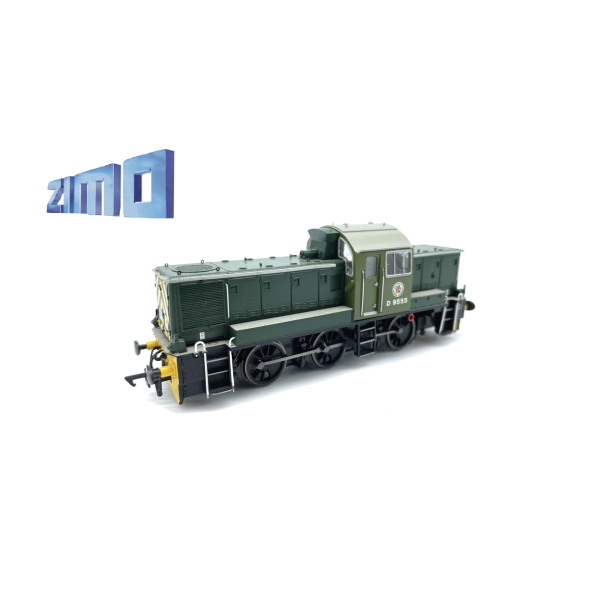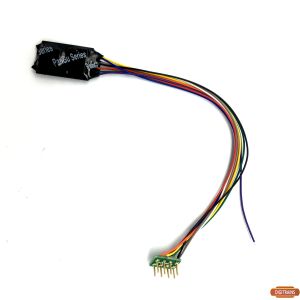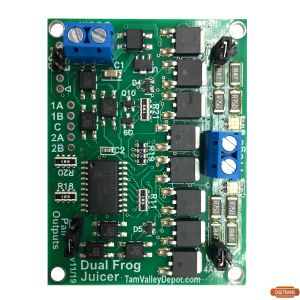ZS14P Class 14 ProtoDrive User Notes
Please spend a few moments to read these notes which have been produced so that you may obtain the maximum satisfaction from your new Class 14 sound scheme
Engine Start Up
When operating on DCC engage F key 1 to turn on the sounds and start the diesel Engine, the Prime Mover (PM)
The engine will crank, start and then settle down into Idle. Your loco will then be ready to drive away.
Throttle Response Scheme.
As supplied, the decoder will behave and sound like a Class 14 with a train on the hook.
After the start-up routine the loco will stand with the Prime Mover ticking over at idle.
The sounds will respond to the throttle control in the following way:
Select speed step 1. The brakes will release, the PM will increase power to get the loco moving, and will continue until at higher speed, a further ramp up will be initiated until the final high speed running sounds begin. The precise speed steps will depend upon your model, so I suggest you make a note of the actual figures for your later use.
The sounds will spool down at similar points on deceleration.
The model can be driven in this way without ever needing to use any control other than the throttle.
For those of you who prefer something more immersive, in this optimised version there are extra control features to further enhance your driving pleasure.
Coasting
No matter what actual speed your model is travelling at, or which engine note range is playing, reducing the throttle by 10 speed steps (of 128) will spool down the engine sounds to ‘Coasting’
The coasting sound will continue until you accelerate; at which point the sounds will change to those relevant to the current speed.
Notch Down
During any driving sound ‘loop’, at any speed, it is possible to cause the engine power to spool down to the level immediately below. This is easily achieved by reducing the speed by a single step only E.g., if the loco is playing power band 3 sounds, reducing speed with your throttle by one step will cause the sound to immediately spool down to the sound of power band 2, if in power band 1, it will spool down to idle.
Acceleration of one speed step or more will immediately ramp the sound back up to the higher power. So you can now, at any road speed, vary the engine note by reducing or adding a single speed step.
Idle Sound
An alternative to automatic coasting or Notch Down, to force the decoder to play engine idling sounds, or to avoid engine ramp up when pottering about the yard, light engine, use F6 at any time.
The sound will move to Idle immediately subject to the decoder’s drive scheme logic.
This key over-rides all other driving sound manipulations. If engaged, F6 will hold and maintain the Idle sound playing (with the exception of turning off the sound with Fkey1). It is therefore important to understand the operation of F6 and monitor its use.
Heavy Train/Light Engine Mode Selection
The default setting is for ‘heavy train’. Inertia is high so acceleration (and deceleration) is restricted.
Activated by F5, Light Engine enables multi-function changes with one key. The switched features include reduced inertia setting to allow more rapid acceleration and engine sounds which accelerate differently.
F5 can be operated at any speed to give another way in which the engine sounds at a given road speed may be modified.
Dynamic Inertia
A combination of new features is included in the automatic operation of the throttle which will affect how the model responds to your control inputs.
The operation is identical in either ‘heavy’ or ‘light’ mode.
Put in simple terms, the wider you open the power controller, the quicker the engine sounds ramp up and the acceleration rate increases correspondingly.
What does this mean in practice?
If you use your controller’s throttle gently, with modest speed step increases, then the engine will rise and fall automatically and the model will accelerate according to the momentum setting. This is by default high for ‘heavy’ and low for ‘light’.
If however, you open the throttle rapidly, the engine will ramp up to full power and acceleration will be approximately 3 times quicker. This change in acceleration rate is variable and dependent upon throttle operation.
Working Brakes
This exciting feature finally enables you to stop your locomotive by using a prototypically progressive braking force which will actually cause your model’s speed to be retarded under you direct control, whatever momentum you have set in CV4.
F2 will give the sound of air brake applications. They can be ‘dabbed’ or held for varying length. The sound will respond accordingly.
However, if the throttle is reduced beforehand, as a real driver would do before braking, a braking force will be applied which will continue to increase the longer F2 is held. Short dabs will provide speed trimming, held down continuously will result in a controlled ‘Emergency Stop’.
PowerCab users please note that the Horn/Whistle button operates the same sound/function as the F2 Key, but set as ‘momentary’. This facilities the precise operation of the brakes and should be used instead of F2.
Other systems may have F2 set to operate as ‘momentary’ by default, or can be set to do so.
Speed Lock
This feature allows the road speed to be locked whilst the throttle control is used to control the engine power sounds playing.
Accurately simulating the sound of a heavy train slowly climbing a gradient with engine at full power is as easy as depicting it coasting down a gradient with the engine at Idle with this single feature.
Here’s how it works.
Engage the Speed Lock Key, (F7) to fix the model’s road speed temporarily. The throttle now directly controls the engine sounds only. Increase speed steps to apply more power, decrease speed steps to spool the engine down to lower power bands or to Idle.
Disengage the Speed Lock Key when you wish to return control of the model’s speed to the throttle.
Enhanced Sound Features
This refers to the inclusion of automatically or semi-automatically generated sounds which more closely replicate what happens in the real world.
Brake Application.
When the loco comes to a halt, the driver will perform several tasks, amongst which will be to set the brakes to prevent movement.
The sound of this action will be heard a few seconds after the loco stops.
This is replicated in your Class 14 model. The feature is fully automatic and prototypical.
Flange Squeal.
Enabled with the F Key 9; if it is not engaged, the Flange Squeal sounds will not play under any circumstances.
If the key is engaged, sounds will operate in the following automated way:
Loco is stationary or comes to a halt. The wheels are not turning and so there would be no flange squeal in reality. No flange sound will play in your model.
Loco is moving slowly. A slow speed flange squeal will play.
Loco is moving more quickly. A faster speed flange squeal will play.
Wagons Snatching and Buffering
Enabled with F Key 13; if it not engaged, the wagon Snatching and Buffering sounds will not play under any circumstances.
If the key is engaged, and the Light Engine Mode (F key 5) is also engaged, the sounds will not play under any circumstances. (No wagons coupled in Light Engine Mode).
If the key is engaged, and the Light Engine Mode (F key 5) is not engaged, sounds will operate in the following automated way:
Loco is stationary. The sounds are not played.
Loco moves off/accelerates gently. The sounds are not played.
Loco moves off/accelerates more rapidly. The sound of the couplings taking up slack as the train stretches plays. This is also the case if the loco accelerates further when already moving.
Loco decelerates gently. The sounds are not played.
Loco decelerates more rapidly. The sound of several wagons buffering up is played each time.
Loco comes to a halt with the Brake Key (F key 2) engaged. The sound of several wagons buffering up is played after it comes to a halt.
This feature is only accessible on DCC
Horns
There are 12 different Horn sounds which are selected automatically by the decoder depending on speed and direction.
These have been included to more closely follow typical practice – short ‘toots’ to warn of intended loco movement and long blasts when travelling at high speed.
These are controlled by F key 3 (single tone) and F key 4 (two tones).
A short ‘Acknowledgement’ version of each will play when the model is stationary.
A different sound will play if the model’s intended direction is changed.
When the loco is moving at speed steps between 1 and 50 different and longer sounds will be played.
When travelling at over 50 speed steps long duration sounds are played.
Each F key can be selected at any time.
Speed Related Detonators
F key 15 enables the warning Detonators to sound. The first explosion is heard immediately, but the time for the subsequent two alerts in the series will depend upon the road speed of the loco.
Since the detonators would be placed at 20m intervals, the faster the road speed, the quicker the sound will repeat.
This time intervals will be calculated by the decoder.
So, when you hear the first ‘bang’, reduce the throttle to zero and hit the Brake Key (F2) for an emergency stop. If you manage to stop the loco in time, you may prevent subsequent detonations.
F 15 must be disengaged and road speed reduced to zero before you will be able to operate this feature again.
Track Noise
Unlike the engine sounds, the track noise is linked to the road speed, becoming faster and more intense as speed increases. This is automatically played as movement begins, so will operate on DC and DCC by default.
Additionally, on DCC, it is possible to disable this sound by engaging F key 8
Shunt Mode
Engage F20 to reduce maximum speed by 50% and remove all inertia and momentum.
This will give finer control of speed and rapid reaction to throttle changes to enable more precise shunting moves.
The sounds will be automatically adjusted to suit.
Live Volume Control
Provided the sound is switched on and the ‘fade’ button is not active, it is possible to change the overall volume to suit changing needs.
Engage F27 and the sound levels will gradually reduce, eventually to silence
Engage F28 and the sound levels will gradually increase, eventually to the maximum set within the sound project.
In each case, disengage the F key when the desired level is attained. Set F27 and F28 as ‘momentary’ if your DCC controller allows you to do so.
Note: If the volume controls appear to not function, check that F19, F27 and F28 are disengaged before making a further attempt.
This feature is only accessible on DCC
|
|
|
|
|
|
|
|
|
|
|
|
F Key
|
Function/Sound
|
|
|
|
|
|
|
|
|
|
0
|
Light Switch Sound plus Lights
|
|
|
|
|
|
|
|
|
|
1
|
Sound On/Off
|
|
|
|
|
|
|
|
|
|
2
|
Brake Key
|
|
|
|
|
|
|
|
|
|
3
|
Speed and Direction Dependent Single Horn
|
|
|
|
|
|
|
|
|
|
4
|
Speed and Direction Dependent Two Tone Horn
|
|
|
|
|
|
|
|
|
|
5
|
Heavy train / Light Engine
|
|
|
|
|
|
|
|
|
|
6
|
Engine Idle/Coasting
|
|
|
|
|
|
|
|
|
|
7
|
Speed Lock Key
|
|
|
|
|
|
|
|
|
|
8
|
Disable Track Noise
|
|
|
|
|
|
|
|
|
|
9
|
Enable Speed Related Flange Squeal
|
|
|
|
|
|
|
|
|
|
10
|
Cab Light
|
|
|
|
|
|
|
|
|
|
11
|
Buffer up
|
|
|
|
|
|
|
|
|
|
12
|
Coupling
|
|
|
|
|
|
|
|
|
|
13
|
Enable Automatic Wagon Buffering
|
|
|
|
|
|
|
|
|
|
14
|
Hand Brake
|
|
|
|
|
|
|
|
|
|
15
|
Speed Related Detonators
|
|
|
|
|
|
|
|
|
|
16
|
Windscreen Wipers
|
|
|
|
|
|
|
|
|
|
17
|
Despatch Whistle
|
|
|
|
|
|
|
|
|
|
18 on
|
Driver’s Door Open
|
|
|
|
|
|
|
|
|
|
18 off
|
Driver’s Door Close
|
|
|
|
|
|
|
|
|
|
19
|
Fade All Sounds
|
|
|
|
|
|
|
|
|
|
20
|
Shunt Mode
|
|
|
|
|
|
|
|
|
|
21
|
-
|
|
|
|
|
|
|
|
|
|
22
|
Shunting Lights (if fitted)
|
|
|
|
|
|
|
|
|
|
23
|
-
|
|
|
|
|
|
|
|
|
|
24
|
-
|
|
|
|
|
|
|
|
|
|
25
|
-
|
|
|
|
|
|
|
|
|
|
26
|
-
|
|
|
|
|
|
|
|
|
|
27
|
Volume Down
|
|
|
|
|
|
|
|
|
|
28
|
Volume Up
|
|
|
|
|
|
|
|
|
|
|
|
|
|
|
|
|
|
|





